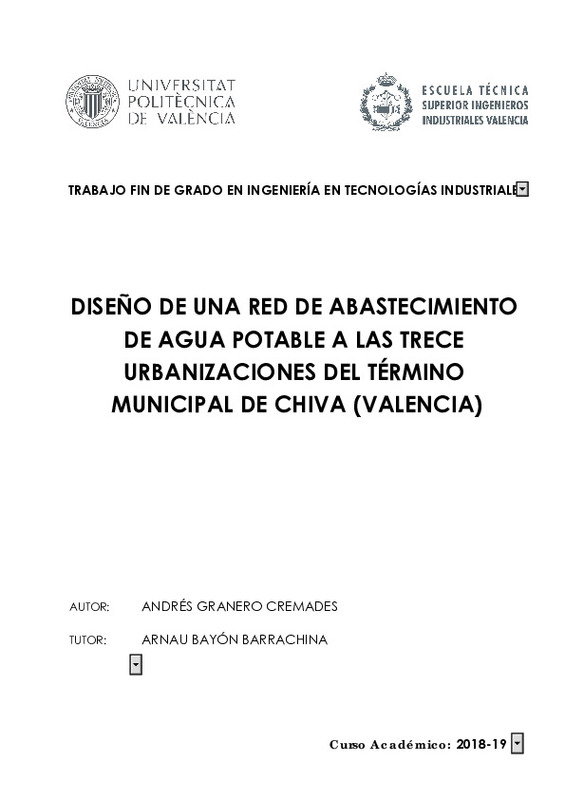|
Resumen:
|
[ES] El presente tiene como objetivo principal satisfacer la necesidad de abastecimiento de agua potable de las urbanizaciones alejadas del núcleo urbano de la localidad de la Villa de Chiva (Valencia). Hasta la fecha, las ...[+]
[ES] El presente tiene como objetivo principal satisfacer la necesidad de abastecimiento de agua potable de las urbanizaciones alejadas del núcleo urbano de la localidad de la Villa de Chiva (Valencia). Hasta la fecha, las viviendas de la zona se valían de una serie de pozos existentes en la zona. No obstante, en la actualidad, la práctica totalidad de ellos presenta una concentración de nitratos muy superior a los umbrales aceptables para consumo humano a causa del abuso de productos fitosanitarios en las explotaciones citrícolas de la zona.
En este contexto, a instancia del propio ayuntamiento de la localidad, el trabajo planteado contempla un sistema de de distribución de agua potable a partir de la planta potabilizadora que abastece al núcleo urbano, situada próxima a este. Dicho sistema plantea una serie de equipos de bombeo conectados a una red de distribución de conducciones forzadas y, dada la considerablemente abrupta orografía de la zona, los depósitos de compensación que se estime necesario.
Para la caracterización de las demandas en cada uno de los múltiples puntos de consumo a abastecer, se emplearán datos de uso de las viviendas de la zona más sofisticados que el padrón municipal, ya que se trata de una zona con alto porcentaje de segundas viviendas, aplicándose los coeficientes de corrección de las demandas que se estime pertinente.
Las distancias y diferencias de cota a salvar para que el suministro llegue a todas las urbanizaciones y viviendas diseminadas por el término municipal se contempla el empleo de los modelos de elevación digital del terreno IGN, tratados con la plataforma de código abierto y libre distribución QGIS. Por último, para el diseño de la red, el alumno se valdrá del modelo numérico también de código abierto y libre distribución EPANET.
[-]
[EN] The main objective of this work is to satisfy the need for drinking water supply of the urbanizations
far from the urban core of the town of Villa de Chiva (Valencia). Until today, the homes in the area
use a series ...[+]
[EN] The main objective of this work is to satisfy the need for drinking water supply of the urbanizations
far from the urban core of the town of Villa de Chiva (Valencia). Until today, the homes in the area
use a series of existing wells in the area. However, currently, almost all of them have a concentration
of nitrates much higher than acceptable thresholds for human consumption due to the abuse of
phytosanitary products in citrus farms in the area.
In this context, at the request of the city council of the town, the proposed work includes a system of
distribution of drinking water from the water treatment plant that supplies the urban center, located
next to it. This system proposes a series of pumping equipment connected to a distribution network
of forced pipes and, given the considerably steep orography of the area, the compensation deposits
that are deemed necessary.
For the characterization of the demands in each of the multiple points of consumption to be
supplied, data on the use of housing in the area more sophisticated than the municipal register will
be used, since it is an area with a high percentage of second homes, applying the correction
coefficients of the demands that are considered pertinent.
The distances and differences of the level to be saved so that the supply reaches all the urbanizations
and homes scattered throughout the municipal area, includes the use of digital elevation models of
the IGN terrain, treated with the open source and free distribution platform QGIS. Finally, for the
design of the network, the student will use the numerical model also open source and free EPANET
distribution.
[-]
|







